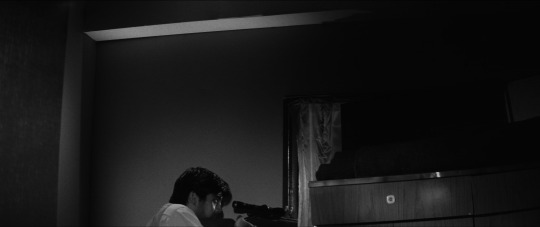#Branded to Kill (1967)
Explore tagged Tumblr posts
Text

Branded To Kill, Seijun Suzuki, 1967
123 notes
·
View notes
Text









Branded to Kill (殺しの烙印, 1967) Dir. Seijun Suzuki
22 notes
·
View notes
Text
'Branded to Kill' – Assassins gone wild on Criterion Channel
Seijun Suzuki’s absolutely mad yakuza movie Branded to Kill (Japan, 1967) blows the genre to smithereens. Jo Shishido stars as Goro Hanada, the Number Three hitman in a crime organization that makes him the next target after the butterfly effect upsets an important mission. Goro is no pushover and easily dispatches the first comers, leaving them splayed in death contortions that could qualify…

View On WordPress
#1967#Blu-ray#Branded to Kill#Criterion Channel#DVD#Japan#Jo Shishido#Koji Nanbara#Seijun Suzuki#VOD#yakuza
2 notes
·
View notes
Text
My favorite album from each year, 1960+.
1960. Blues & Roots - Charles Mingus 1961. Blue Hawaii - Elvis Presley 1962. Jazz Samba - Stan Getz with Charlie Byrd 1963. The Freewheelin' Bob Dylan - Bob Dylan 1964. The Times They Are A-Changin' - Bob Dylan 1965. Bringing It All Back Home - Bob Dylan 1966. Blonde on Blonde - Bob Dylan. 1967. Are You Experienced - Jimi Hendrix 1968. Beggars Banquet - The Rolling Stones 1969. Let It Bleed - The Rolling Stones 1970. Bridge Over Troubled Water - Simon & Garfunkel 1971. Led Zeppelin IV - Led Zeppelin 1972. Harvest - Neil Young 1973. Pronounced - Lynyrd Skynyrd 1974. Pretzel Logic - Steely Dan 1975. Born To Run - Bruce Springsteen 1976. Turnstiles - Billy Joel 1977. Rumours - Fleetwood Mac 1978. Excitable Boy - Warren Zevon 1979. Rust Never Sleeps - Neil Young 1980. Heartattack And Vine - Tom Waits 1981. Moving Pictures - Rush 1982. The Number of the Beast - Iron Maiden 1983. Kill 'Em All - Metallica 1984. Purple Rain - Prince 1985. Hounds of Love - Kate Bush 1986. Graceland - Paul Simon 1987. Appetite For Destruction - Guns N' Roses 1988. ...And Justice For All - Metallica 1989. Doolittle - Pixies 1990. People's Instinctive Travels and the Paths of Rhythm - A Tribe Called Quest 1991. Nevermind - Nirvana 1992. Rage Against the Machine - Rage Against the Machine 1993. Enter The Wu-Tang - Wu-Tang Clan 1994. Weezer (The Blue Album) - Weezer 1995. Jagged Little Pill - Alanis Morissette 1996. Beautiful Freak - Eels 1997. Either/Or - Elliott Smith 1998. Mezzanine - Massive Attack 1999. Californication - Red Hot Chili Peppers 2000. Heartbreaker - Ryan Adams 2001. Toxicity - System of a Down 2002. Yoshimi Battles the Pink Robots - The Flaming Lips 2003. Deja Entendu - Brand New 2004. Hot Fuss - The Killers 2005. Takk... - Sigur Rós 2006. One-X - Three Days Grace 2007. Oracular Spectacular - MGMT 2008. 808s & Heartbreak - Kanye West 2009. Man On The Moon: The End of Day - Kid Cudi 2010. My Beautiful Dark Twisted Fantasy - Kanye West 2011. Watch The Throne - Jay-Z 2012. Born To Die - Lana Del Rey 2013. Pure Heroine - Lorde 2014. Ultraviolence - Lana Del Rey 2015. To Pimp A Butterfly - Kendrick Lamar 2016. Puberty 2 - Mitski 2017. Cult Drugs - Blood Command 2018. Goodbye & Good Riddance - Juice WRLD 2019. Norman Fucking Rockwell! - Lana Del Rey 2020. The New Abnormal - The Strokes 2021. The Horses and the Hounds - James McMurtry 2022. It's Almost Dry - Pusha T 2023. World Music Radio - Jon Batiste 2024. The Past Is Still Alive - Hurray For The Riff Raff
61 notes
·
View notes
Text

Branded to Kill (1967), Dir. Seijun Suzuki
1K notes
·
View notes
Photo

Annu Mari in Koroshi no rakuin aka Branded to Kill (1967)
424 notes
·
View notes
Photo






Branded to Kill (1967) dir. Seijun Suzuki
Cinematography by Kazue Nagatsuka
#branded to kill#seijun suzuki#kazue nagatsuka#film#japanese film#cinema#movie#movie stills#film frames#cinematography
232 notes
·
View notes
Text
Side by Side


À double tour (1959) Claude Chabrol
Branded to kill (1967) Seijun Suzuki
24 notes
·
View notes
Photo




Branded to Kill (1967) dir. Seijun Suzuki
306 notes
·
View notes
Note
hello!! would you happen to have any yakuza film recs? primarily interested in ninkyo eiga (love the conflict of duty vs personal feelings) but open to anything not on that topic as well. thank you!
i’m sorry, i’m not very familiar with yakuza films outside of seijun suzuki’s works and akira kurosawa and takashi miike’s flirtations with the genre, so my recommendations wouldn’t be any better than anyone else’s (branded to kill (1967), stray dog (1949), gozu (2003), all the surface level films). however, i am very well-acquainted with the hong kong cousin of ninkyo eiga yakuza genre, heroic bloodshed films, and some of my favorites in the more chivalric/wuxia-descended vein are a better tomorrow (1986), as tears go by (1987), the killer (1989), infernal affairs (2002), jiang hu (2004), spl: kill zone (2005), election (2005), and election ii (2006) :)
9 notes
·
View notes
Text

Branded to Kill
dir. Seijun Suzuki
1967
6 notes
·
View notes
Text
By Thom Hartmann
Back in 1967, a friend of mine and I hitchhiked from East Lansing, Michigan to San Francisco to spend the summer in Haight-Ashbury. One ride dropped us off in Sparks, Nevada, and within minutes of putting our thumbs out a city police car stopped and arrested us for vagrancy.
The cop, a young guy with an oversized mustache who was apologetic for the city’s policy, drove us to the desert a mile or so beyond the edge of town, where we hitchhiked standing by a distressing light-post covered with graffiti reading “39 hours without a ride,” “going on our third day,” and “anybody got any water?”
Vagrancy laws were so 20th century.
Today, the US Supreme Court heard a case involving efforts by the City of Grants Pass, Oregon to keep homeless people off its streets and out of its parks and other public property. The city had tried a number of things when the problem began to explode in the last year of the Trump administration, as The Oregonian newspaper notes:
“They discussed putting them in their old jail, creating an unwanted list, posting signs at the city border or driving people out of town... Currently, officers patrol the city nearly every day, Johnson said, handing out [$295] citations to people who are camping or sleeping on public property or for having too many belongings with them.”
The explosion in housing costs has triggered two crises: homelessness and inflation. The former is harming the livability of our cities and towns, and the Fed’s reaction to the latter threatens an incumbency-destroying recession just as we head into what will almost certainly be the most important election in American history.
The problem with housing inflation is so severe today that without it the nation’s overall core CPI inflation rate would be in the neighborhood of Fed Chairman Jerome Powell’s 2% goal.

Graphic based on BLM data and interpretation by The Financial Times
Both homelessness and today’s inflation are the result of America — unlike many other countries — allowing housing to become a commodity that can be traded and speculated in by financial markets and overseas investors.
Forty-three years into America’s Reaganomics experiment, homelessness has gone from a problem to a crisis. Rarely, though, do you hear that Wall Street — a prime beneficiary of Reagan’s deregulation campaign — is helping cause it.
32% seems to be the magic threshold, according to research funded by the real estate listing company Zillow. When neighborhoods hit rent rates in excess of 32% of neighborhood income, homelessness explodes.
And we’re seeing it play out right in front of us in cities across America because a handful of Wall Street billionaires want to make a killing.
It wasn’t always this way in America.
Housing prices have spun out of control since my dad bought his house in 1957 when I was six years old. He got a Veteran’s Administration-subsidized loan and picked up the brand-new 3-bedroom-1-bath ranch house my 3 brothers and I grew up in, in suburban south Lansing, Michigan. It cost him $13,000, which was about twice what he made every year working a good union job in a tool-and-die shop.
When my dad bought his home in the 1950s the median price of a single-family house was 2.2 times the median American family income. Today, the Fed says, the median house sells for $479,500 while the median American personal income is $41,000 — a ratio of more than ten-to-one between housing costs and annual income.
As the Zillow study notes:
“Across the country, the rent burden already exceeds the 32% [of median income] threshold in 100 of the 386 markets included in this analysis….”
And wherever housing prices become more than three times annual income, homelessness stalks like the grim reaper.
We’re told that America’s cities have seen this increase in housing costs since the 1950s in some part because of the growing wealth and population of this country. There were, after all, 168 million people in the US the year my dad bought his house; today there are 330 million.
And it’s true that we haven’t been building enough new housing, particularly low-income housing, as 43 years of neoliberal Reaganomics have driven down wages and income for working-class people relative to all of their expenses while stopping the construction of virtually any new subsidized low-income housing.
But that’s not the only, or even the main dynamic, driving housing prices into the stratosphere — and, as a consequence, the crisis in homelessness — over the past decade. You can thank speculation for much of that.
As the Zillow-funded study noted:
“This research demonstrates that the homeless population climbs faster when rent affordability — the share of income people spend on rent — crosses certain thresholds. In many areas beyond those thresholds, even modest rent increases can push thousands more Americans into homelessness.”
So how did we get here?
It started with a wave of foreign buyers over the past 30 years (particularly from China, Canada, Mexico, India and Colombia) who, in just the one single year of 2020, picked up over 154,000 homes as their way of parking money in America. Which is part of why there are over 20 times more empty houses in America than there are homeless people.
As Marketwatch noted in a 2015 article titled “The Danger of Foreign Buyers Gobbling Up American Homes”:
“Unusual high appreciation of the aforementioned urban centers is due to the ever growing influx of foreign buyers — mostly wealthy Chinese — who view American residential real estate as the safest investment commodity. … According to a National Realtors Association survey, the Chinese spent $22 billion on U.S. housing in 12 months through March 2014…. [Other foreign buyers primarily include] Canadians, British, Indians and Mexicans.”
But foreign investment has been down for the past few years; what’s taken over and is really driving home prices today are massive, multi-billion-dollar US-based funds that sweep into neighborhoods and buy everything available, bidding against families and driving up housing prices.
As noted in a Wall Street Journal article titled “Meet Your New Landlord: Wall Street,” in just one suburb (Spring Hill) of Nashville, “In all of Spring Hill, four firms … own nearly 700 houses … [which] amounts to about 5% of all the houses in town.”
This is the tiniest tip of the iceberg.
“On the first Tuesday of each month,” notes the Journal article about a similar phenomenon in Atlanta, investors “toted duffels stuffed with millions of dollars in cashier’s checks made out in various denominations so they wouldn’t have to interrupt their buying spree with trips to the bank…”
The same thing is happening in cities and suburbs all across America; the investment goliaths use finely-tuned computer algorithms to sniff out houses they can turn into rental properties, making over-market and unbeatable cash bids often within minutes of a house hitting the market.
After stripping neighborhoods of homes families can buy, they then begin raising rents as high as the market will bear.
In the Nashville suburb of Spring Hill, for example, the vice-mayor, Bruce Hull, told the Journal you used to be able to rent “a three bedroom, two bath house for $1,000 a month.” Today, the Journal notes:
“The average rent for 148 single-family homes in Spring Hill owned by the big four [Wall Street investor] landlords was about $1,773 a month…”
Ryan Dezember, in his book Underwater: How Our American Dream of Homeownership Became a Nightmare, describes the story of a family trying to buy a home in Phoenix. Every time they entered a bid, they were outbid instantly, the price rising over and over, until finally the family’s father threw in the towel.
“Jacobs was bewildered,” writes Dezember. “Who was this aggressive bidder?”
Turns out it was Blackstone Group, now the world’s largest real estate investor. At the time they were buying $150 million worth of American houses every week, trying to spend over $10 billion. And that’s just a drop in the overall bucket.
In 2018, corporations bought 1 out of every 10 homes sold in America, according to Dezember, noting that, “Between 2006 and 2016, when the homeownership rate fell to its lowest level in fifty years, the number of renters grew by about a quarter.”
This all really took off around a decade ago, when Morgan Stanley published a 2011 report titled “The Rentership Society,” arguing that — in the wake of the 2008 Bush Housing Crash — snapping up houses and renting them back to people who otherwise would have wanted to buy them could be the newest and hottest investment opportunity for Wall Street’s billionaires and their funds.
Turns out, Morgan Stanley was right. Warren Buffett, KKR, and The Carlyle Group have all jumped into residential real estate, along with hundreds of smaller investment groups, and the National Home Rental Council has emerged as the industry’s premier lobbying group, working to block rent control legislation and other efforts to regulate the industry.
As John Husing, the owner of Economics and Politics Inc., told The Tennessean newspaper:
“What you have are neighborhoods that are essentially unregulated apartment houses. It could be disastrous for the city.”
Meanwhile, as unionization levels here remain among the lowest in the developed world, Reagan’s ongoing war on working people continues to wipe out America’s families.
At the same time that housing prices, both to purchase and to rent, are being driven through the roof by foreign and Wall Street investors, a survey published by NPR, the Robert Wood Johnson Foundation, and the Harvard TH Chan School of Public Health found that American families are in crisis.
Their study found:
— “Thirty-eight percent (38%) of [all] households across the nation report facing serious financial problems in the previous few months.
— “There is a sharp income divide in serious financial problems, as 59% of those with annual incomes below $50,000 report facing serious financial problems in the past few months, compared with 18% of households with annual incomes of $50,000 or more.
— “These serious financial problems are cited despite 67% of households reporting that in the past few months, they have received financial assistance from the government.
— “Another significant problem for many U.S. households is losing their savings during the COVID-19 outbreak. Nineteen percent (19%) of U.S. households report losing all of their savings during the COVID-19 outbreak and not currently having any savings to fall back on.
— “At the time the Centers for Disease Control and Prevention’s (CDC) eviction ban expired, 27% of renters nationally reported serious problems paying their rent in the past few months.”
These are not separate issues, and they are driving an explosion in homelessness.
The Zillow study found similarly damning data:
— “Communities where people spend more than 32% of their income on rent can expect a more rapid increase in homelessness.
— “Income growth has not kept pace with rents, leading to an affordability crunch with cascading effects that, for people on the bottom economic rung, increases the risk of homelessness.
— “The areas that are most vulnerable to rising rents, unaffordability, and poverty hold 15% of the U.S. population — and 47% of people experiencing homelessness.”
The Zillow study makes grim reading and is worth checking out. In community after community, when rent prices exceeded 32% of median household income, homelessness exploded. It’s measurable, predictable, and is destroying what’s left of the American working class, particularly minorities.
The loss of affordable homes also locks otherwise middle-class families out of the traditional way wealth is accumulated — through homeownership: Over 61% of all American middle-income family wealth is their home’s equity. And as families are priced out of ownership and forced to rent, they become more vulnerable to long-term economic struggles and homelessness.
Housing is one of the primary essentials of life. Nobody in America should be without it, and for society to work, housing costs must track incomes in a way that makes housing both available and affordable. This requires government intervention in the so-called “free market.”
— Last year, Canada banned most foreign buyers from buying residential property as a way of controlling their housing inflation.
— New Zealand similarly passed its no-foreigners law (except for Singaporeans and Australians) in 2018.
— Thailand requires a minimum investment of $1.2 million and the equivalent of a green card.
— Greece bans most non-EU citizens from buying real estate in most of the country.
— To buy residential housing in Denmark, it must be your primary residence and you must have lived in the country for at least 5 years.
— Vietnam, Austria, Hungary, and Cyprus also heavily restrict who can buy residential property, where, and under what terms.
This isn’t rocket science; the problem could be easily fixed by Congress if there was a genuine willingness to protect our real estate market from the vultures who’ve been circling it for years.
Unfortunately, when Clarence Thomas was the deciding vote to allow billionaires and hedge funds to legally bribe members of Congress in Citizens United, he and his four fellow Republicans opened the floodgates to “contributions” and “gifts” from foreign and Wall Street interests to pay off legislators to ignore the problem.
Because there’s no lobbying group for the interests of average homeowners or the homeless, it’s up to us to raise hell with our elected officials. The number for the Congressional switchboard is 202-224-3121.
If ever there was a time to solve this problem — and regulate corporate and foreign investment in American single-family housing — it’s now.
#us politics#op ed#thom hartmann#hartmann report#common dreams#homelessness#end homelessness#housing#housing market#2024#Reaganomics#zillow#foreign buyers#Marketwatch#the Oregonian#Wall Street Journal#Ryan Dezember#Underwater: How Our American Dream of Homeownership Became a Nightmare#The Rentership Society#Morgan Stanley#The Tennessean#NPR#Robert Wood Johnson Foundation#Harvard TH Chan School of Public Health#affordable housing
16 notes
·
View notes
Text

Joe Shishido, December 6, 1933 – January 18, 2020.
Seijun Suzuki’s Branded to Kill (1967).
21 notes
·
View notes
Text
This'll probably be my final post on this subject, tbh, it's exhausting. Also, it's long. TW: Oppression, anti-Palestinian racism, antisemitism, settler-colonialism, pogroms.
EMBRACE COMPLEXITY. TURN AWAY FROM SIMPLISTIC NARRATIVES.
A lot of people are treating this like it's a football match, and that their "side" can do no wrong, when in reality it is entirely possible to be aware of and hold both violences in your mind, while also being aware of the power dynamics in play.
For Jews, this is the largest pogrom since the Shoah. (And yes, I'm calling it a pogrom. That seems more accurate to me than "terrorist attack".) The terror and distress resulting from that is built on millennia of pogroms, not just settler fears the way white USAmericans would fear a reprisal from Indigenous people. Half of all Jews in the world live in Israel, and nearly every Jewish person in the world at least knows someone who's lost someone in this attack. The fear is real. As I type this, my aunt and uncle who live in northern Israel were instructed to shelter in a safe room because a Hezbollah [Edit: Hamas] bomb was just dropped on the Ofer Forest.
For Palestinians, armed reprisal was pretty much the only option left after decades of apartheid and oppression by the Israeli government. Just in 2014, for example, Operation Protective Edge killed over 2000 Palestinians, most of whom were civilians. Even in reaction to this very attack, the Israeli government's response was to commit a war crime and impose a total blockade on Gaza, blocking food, water, medicine, fuel, and electricity to approximately 2.3 million people. The fact that they even can do that speaks to the tremendous power imbalance at play, to say nothing of Israel's alleged nuclear capabilities that I'm sure the USA knows absolutely nothing about because if they did Israel would be in violation of nuclear nonproliferation treaties and the US would be obligated to sanction them.
So, I honestly don't know what to say. I don't want to say "it's different when Palestinians do it", because at the end of the day it was still a pogrom, and it's hurt more non-IDF Jews than any single attack since the Shoah, and a lot of people are in mourning. But I also don't want to say "how dare they, I condemn this," because what the hell else are Palestinians supposed to do? They have a fundamental right to live freely and equally in Palestine. They've tried everything else, and the Israeli government's response has consistently been to just bomb the shit out of Gaza, or flood the West Bank with settlers and soldiers, or deny life-sustaining utilities that Israel controls like water and electricity to millions of people. What else is left but armed resistance, at that point?
I mean, shit, we could question whether Hamas really represents the interests of the Gazans it governs or not, or we could debate whether their constitution change in 2017 (they scrubbed most of the religious wording, explicitly denounced antisemitism and specifically condemned colonialism, and even expressed a willingness to acknowledge pre-1967 Israeli borders) is sincere, or whether branding them as simply terrorists is in any way useful, or we could even talk about how Netanyahu supported the funding of Hamas to sap support from Fatah's more progressive stance and forestall any real dialogue.
Or we could debate the concept of "civilian" in a settler colony where the only reason Israeli civilians can even live there as Israelis is through the brutal violence inflicted by the IDF, or the dynamics of how a country with mandatory army service for everyone blurs the distinction between soldier and civilian in the first place, or how the Israeli government has gone hard-right over the past year and an attack like this is exactly what Likud needed in silencing dissent within Israel.
(As for my personal opinion, I think the Likud government damn near deliberately provoked this pogrom with their bullshit on al-Aqsa as an opportunity to manufacture outrage and look strong, knowing full well how many people would get hurt, so that the issue of judicial review gets swept under the rug in the fires of war and revenge. The Israeli government cares more about hurting Palestinians and defending the idea of a "Jewish state" than actually protecting Israeli lives, otherwise they'd have been working to de-escalate and end their apartheid decades ago.)
Shit's complicated. But that's fine. People can understand complicated things. It just takes longer than reading something short and quippy, and it requires you to interrogate your own internal narratives for both antisemitism and anti-Palestinian racism. Also, leave people who are in mourning the fuck alone.
29 notes
·
View notes
Text










‘Branded to Kill’ (1967). Directed by Seijun Suzuki.
44 notes
·
View notes

